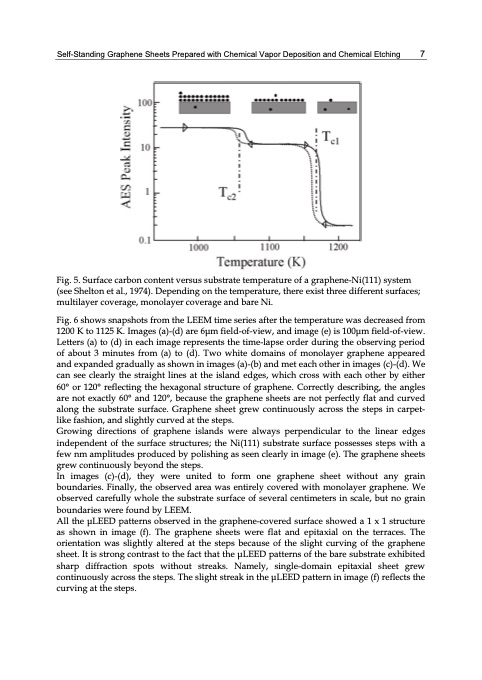
PDF Publication Title:
Text from PDF Page: 017
Self-Standing Graphene Sheets Prepared with Chemical Vapor Deposition and Chemical Etching 7 Fig. 5. Surface carbon content versus substrate temperature of a graphene-Ni(111) system (see Shelton et al., 1974). Depending on the temperature, there exist three different surfaces; multilayer coverage, monolayer coverage and bare Ni. Fig. 6 shows snapshots from the LEEM time series after the temperature was decreased from 1200 K to 1125 K. Images (a)-(d) are 6μm field-of-view, and image (e) is 100μm field-of-view. Letters (a) to (d) in each image represents the time-lapse order during the observing period of about 3 minutes from (a) to (d). Two white domains of monolayer graphene appeared and expanded gradually as shown in images (a)-(b) and met each other in images (c)-(d). We can see clearly the straight lines at the island edges, which cross with each other by either 60° or 120° reflecting the hexagonal structure of graphene. Correctly describing, the angles are not exactly 60° and 120°, because the graphene sheets are not perfectly flat and curved along the substrate surface. Graphene sheet grew continuously across the steps in carpet- like fashion, and slightly curved at the steps. Growing directions of graphene islands were always perpendicular to the linear edges independent of the surface structures; the Ni(111) substrate surface possesses steps with a few nm amplitudes produced by polishing as seen clearly in image (e). The graphene sheets grew continuously beyond the steps. In images (c)-(d), they were united to form one graphene sheet without any grain boundaries. Finally, the observed area was entirely covered with monolayer graphene. We observed carefully whole the substrate surface of several centimeters in scale, but no grain boundaries were found by LEEM. All the μLEED patterns observed in the graphene-covered surface showed a 1 x 1 structure as shown in image (f). The graphene sheets were flat and epitaxial on the terraces. The orientation was slightly altered at the steps because of the slight curving of the graphene sheet. It is strong contrast to the fact that the μLEED patterns of the bare substrate exhibited sharp diffraction spots without streaks. Namely, single-domain epitaxial sheet grew continuously across the steps. The slight streak in the μLEED pattern in image (f) reflects the curving at the steps.PDF Image | GRAPHENE SYNTHESIS CHARACTERIZATION PROPERTIES

PDF Search Title:
GRAPHENE SYNTHESIS CHARACTERIZATION PROPERTIESOriginal File Name Searched:
Graphene-Synthesis.pdfDIY PDF Search: Google It | Yahoo | Bing
Salgenx Redox Flow Battery Technology: Power up your energy storage game with Salgenx Salt Water Battery. With its advanced technology, the flow battery provides reliable, scalable, and sustainable energy storage for utility-scale projects. Upgrade to a Salgenx flow battery today and take control of your energy future.
| CONTACT TEL: 608-238-6001 Email: greg@infinityturbine.com | RSS | AMP |